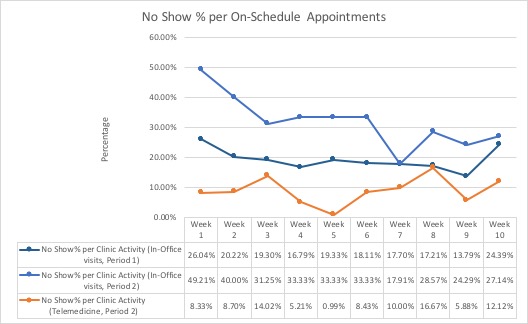Session Information
Session Type: Poster Session D
Session Time: 9:00AM-11:00AM
Background/Purpose: The COVID-19 pandemic has tremendously affected the healthcare sector. State of Ohio officials recommended to hold in-person outpatient visits and elective procedures to limit virus spread. Many patients with chronic illnesses had reduced access to healthcare, this prompted the necessity to take active steps to continue delivering healthcare while ensuring safety for both patients and healthcare providers.
The MetroHealth System is an academic, public health care institution that services the population of Cuyahoga County in Cleveland, OH. Within 1 week of the State of Ohio issuing a statewide order limiting gatherings in March 2020, the Rheumatology outpatient clinics implemented telemedicine by video or telephone limiting in person visit sonly when deemed medically necessary. Anecdotally, Rheumatology providers reported improved clinic show rates with telemedicine visits, prompting this quality improvement project.
Our aim is to investigate and compare completed visit, no show, and cancellation rates between in-person and telemedicine appointments to see if telemedicine has a beneficial impact on access to Rheumatology ambulatory clinics
Methods: Using Reporting Workbench in our Epic electronic health record, we collected data retrospectively pertaining to rheumatology outpatient appointments at the MetroHealth System between Jan 3-May 31, 2020 – a 20-week period. Appointments were allocated into 3 categories: canceled; no-show; and completed. Data was segmented into in-person versus telemedicine, weekly stratified. figures 1-3.
For analysis, the data was divided into two 10-week periods: period 1, the pre-COVID19 interval (Jan 3-Mar 15, 2020) and period 2, during COVID19 pandemic (Mar16-May 31, 2020). During period 1, the only modality was in-person visits, while during period 2 telemedicine started taking place in addition to in-person visits. Appointment Activity denoted the sum of cancellations, no shows, and completed visits. On-Schedule appointment totals summed no show and completed visits. Rates of cancelations, no shows, and completed visits were compared to Appointment Activity totals as well as On-Schedule totals.
Results: Telemedicine appointment cancellations were nearly zero (1 out of 825 telemedicine appointments offered) in the 10-week During COVID-19 period as compared to the pre-COVID-19 period where 527 appointments were cancelled, all in-person appointments. No shows also trended down in period 2 when there were 191 no shows (121 in-person and 70 telemedicine) versus 220 no shows in period 1 where only in-person visits were offered. This led to a slight increase in completed visits During COVID-19 when 1038 had a completed appointment (754 telemedicine and 284 in-person); whereas, pre-COVID-19 resulted in 930 completed in-person.
Conclusion: Barriers to accessing in-person healthcare because of transportation or other issues has been a challenge that might be conquered by telemedicine. The offering of telemedicine had seemingly favorable impacts on access to Rheumatology ambulatory clinics at our academic, public health system. We encourage examining the incorporation of telemedicine in our routine clinic visits to improve patient’s appointment adherence.
 This graph illustrates overall cancelation rates: # canceled/ appointment activity (cancels + no shows + completed) – Period 1 is between Jan 3rd to Mar 15th, before the initial State of Ohio executive order responding to the COVID-19 pandemic – Period 2 is between Mar 16th – May 31st, immediately following the initial State of Ohio executive order responding to the COVID-19 pandemic
This graph illustrates overall cancelation rates: # canceled/ appointment activity (cancels + no shows + completed) – Period 1 is between Jan 3rd to Mar 15th, before the initial State of Ohio executive order responding to the COVID-19 pandemic – Period 2 is between Mar 16th – May 31st, immediately following the initial State of Ohio executive order responding to the COVID-19 pandemic
 This graph illustrates completed visit rate per on-schedule appointments: # completed visits/ on-schedule appointments (completed visits+ no show). – Period one is between Jan 3rd to Mar 15th, before the initial State of Ohio executive order responding to the COVID-19 pandemic – Period two is between Mar 16th – May 31st, immediately following the initial State of Ohio executive order responding to the COVID-19 pandemic
This graph illustrates completed visit rate per on-schedule appointments: # completed visits/ on-schedule appointments (completed visits+ no show). – Period one is between Jan 3rd to Mar 15th, before the initial State of Ohio executive order responding to the COVID-19 pandemic – Period two is between Mar 16th – May 31st, immediately following the initial State of Ohio executive order responding to the COVID-19 pandemic
 This graph illustrates no-show rate per on-schedule appointments: # no show/on-schedule appointments (completed+ no show) – Period 1 is between Jan 3rd to Mar 15th, before the initial State of Ohio executive order responding to the COVID-19 pandemic – Period two is between Mar 16th – May 31st, immediately following the initial State of Ohio executive order responding to the COVID-19 pandemic
This graph illustrates no-show rate per on-schedule appointments: # no show/on-schedule appointments (completed+ no show) – Period 1 is between Jan 3rd to Mar 15th, before the initial State of Ohio executive order responding to the COVID-19 pandemic – Period two is between Mar 16th – May 31st, immediately following the initial State of Ohio executive order responding to the COVID-19 pandemic
To cite this abstract in AMA style:
Alkilany R, Hong R. Telemedicine Visits During COVID-19 Improved Clinic Show Rates [abstract]. Arthritis Rheumatol. 2020; 72 (suppl 10). https://acrabstracts.org/abstract/telemedicine-visits-during-covid-19-improved-clinic-show-rates/. Accessed .« Back to ACR Convergence 2020
ACR Meeting Abstracts - https://acrabstracts.org/abstract/telemedicine-visits-during-covid-19-improved-clinic-show-rates/
